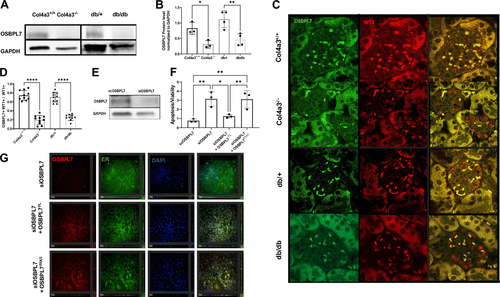Fig. 1 Decreased OSBPL7 expression in mouse models of experimental CKD is associated with podocyte injury. A and B: representative Western blot images (A) and quantification showing OSBPL7 levels in the kidney cortex of Col4a3?/? and db/db mice compared with Col4a3+/+ (n = 3, *P < 0.05) and db/+ (n = 4, **P < 0.001) littermates (B). C: immunofluorescence staining showcasing OSBPL7 (green) and WT1 (red) in glomeruli, with the merged image highlighting their colocalization, indicating OSBPL7's association with podocytes. D: quantification of OSBPL7 and WT1 colocalization, presented as the ratio of OSBPL7/WT1 double-positive signals to total WT1-positive cells, showing the significant decrease in OSBPL7 in the glomeruli of CKD models compared with controls (n = 10, ****P < 0.0001). E: stable OSBPL7-deficient (SiOSBPL7) podocytes were generated using siRNA. F: apoptosis levels increased in OSBPL7-deficient podocytes and returned to control levels with transfection of full-length OSBPL7 (OSBPL7FL) but not with transfection of OSBPL7 plasmid containing a deletion of the FFAT domain (OSBPL7FFAT?). n = 3 technical replicates. *P < 0.05 and **P < 0.01. G: immunofluorescent images of OSBPL7 (red), ER stain (green), and DAPI (blue) in siOSBPL7 cells with and without OSBPL7FL or OSBPL7FFAT? expressing plasmid. CKD, chronic kidney disease; OSBPL7, oxysterol-binding protein-like 7.
Image
Figure Caption
Acknowledgments
This image is the copyrighted work of the attributed author or publisher, and
ZFIN has permission only to display this image to its users.
Additional permissions should be obtained from the applicable author or publisher of the image.
Full text @ Am. J. Physiol. Renal Physiol.

